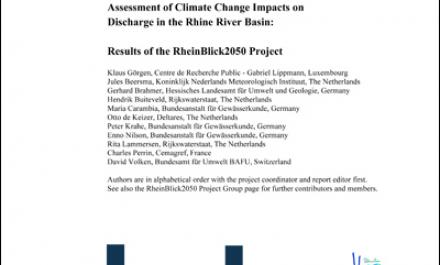Date of publication
Code
I-
23
Document language
English
Image

Download
Rapport I-23 [22.74 MB]
Download parts
Rapport I-23 Erratum [208.9 KB]
Table of contents
| Reading Guide | |
| CHR / RheinBlick2050 Project Group | |
| Acknowledgements | |
| Foreword | |
| General Information on the International Commission for the Hydrology of the Rhine Basin (CHR) | |
| Table of Contents | |
| Summary | |
| 1 | Introduction |
| 1.1 | State of the Art |
| 1.2 | Study Motivation and Objectives |
| 1.3 | Study Area |
| 1.4 | Structure of the Report |
| 2 | Overview of Available Data and Processing Procedures |
| 2.1 | Overview of Datasets |
| 2.1.1 | Discharge Reference Data |
| 2.1.2 | Hydrometeorological Reference Data |
| 2.1.3 | Climate Change Projections |
| 2.2 | Atmospheric Data Processing |
| 2.2.1 | Temporal and Spatial Aggregation |
| 2.2.2 | Bias-Correction Methods |
| 2.3 | Rainfall Generator |
| 2.4 | Hydrological Models |
| 2.4.1 | Short Overview |
| 2.4.2 | Semi-Distributed Model HBV |
| 2.4.3 | Lumped Models |
| 2.4.4 | Evaporation Approaches |
| 2.5 | Model Coupling Experiment and Analyses Design, Limitations |
| 2.5.1 | Data Flowpath |
| 2.5.2 | Target Measures |
| 2.5.3 | Representation of Results |
| 2.5.4 | Limitations of the Experiment Design |
| 3 | Evaluation of Data and Processing Procedures |
| 3.1 | Evaluation and Selection of Climate Model Runs |
| 3.1.1 | Evaluation of Spatial Structures Based on Annual Means (Step 1) |
| 3.1.2 | Evaluation of the Annual Cycle (Step 2) |
| 3.1.3 | Outlier Identification (Step 3) |
| 3.1.4 | Discussion and Selection (Step 4) |
| 3.1.5 | Conclusion |
| 3.2 | Effects of Bias-Correction and Time-Series Resampling |
| 3.2.1 | Results of Bias-Correction |
| 3.2.2 | Combined Results of Resampling and Bias-Correction |
| 3.2.3 | Limitations of the Bias-Corrected Resampled Series |
| 3.2.4 | Conclusions |
| 3.3 | Hydrological Model Performance and Uncertainty Analysis |
| 3.3.1 | Model Performance Evaluation over the Reference Period |
| 3.3.2 | Quantification of Model Uncertainty |
| 3.3.3 | Conclusions |
| 3.4 | Comparison of HBV134-Simulations with Observed Target Statistics |
| 3.4.1 | Validation Results |
| 3.4.2 | Discussion of the Validation Results |
| 3.4.3 | Conclusions |
| 3.5 | Overall Conclusions of the validation |
| 4 | Meteorological Changes in the Rhine River Basin |
| 4.1 | Data and Methods |
| 4.2 | Annual Cycles Changes |
| 4.3 | Seasonal Changes |
| 4.4 | Robustness of the Precipitation Change Sinals |
| 4.5 | Conclusions |
| 5 | Changes in Mean Flow in the Rhine River Basin |
| 5.1 | Data and Methods |
| 5.2 | Projected Changes for Mean Flows |
| 5.3 | Conclusions |
| 6 | Low Flow Changes in the Rhine River Basin |
| 6.1 | Data and Methods |
| 6.2 | Low Flow (NM7Q) |
| 6.3 | Low Flow (FDC_Q90) |
| 6.4 | Conclusions |
| 7 | High Flow Changes in the Rhine River Basin |
| 7.1 | Data and Methods |
| 7.2 | Projected Changes for High Flows |
| 7.3 | Conclusions |
| 8 | Report Summary and Overall Conclusions |
| 9 | Outlook |
| References | |
| Figures | |
| Tables | |
| Nomenclatures, Definitaions, Abbreviations and Acronyms | |
| CHR Publications | |
|
Appendix |
|
| A | Target Measures |
| A.1 | Questionnaire |
| A.2 | Feedback |
| B | Regional Climate Change Projections Data Overview |
| C | Hydrological Model Features |
| D | Performance of Hydrological Models |
| D.1 | Detailed Results of Hydrological Models over the Reference Period (1961-1990) |
| D.2 | Hydrological Model Testing |
| E | Air Temperature and Precipitation Changes |
| F | Extreme Value Analyses of Simulated Discharges |
| G | Flood Statistics Provided by the German Federal States and Rijkswaterstaat |
| Additional Material | |
| Individual Authors Contributions Overview | |
| Colophon |
Official reports